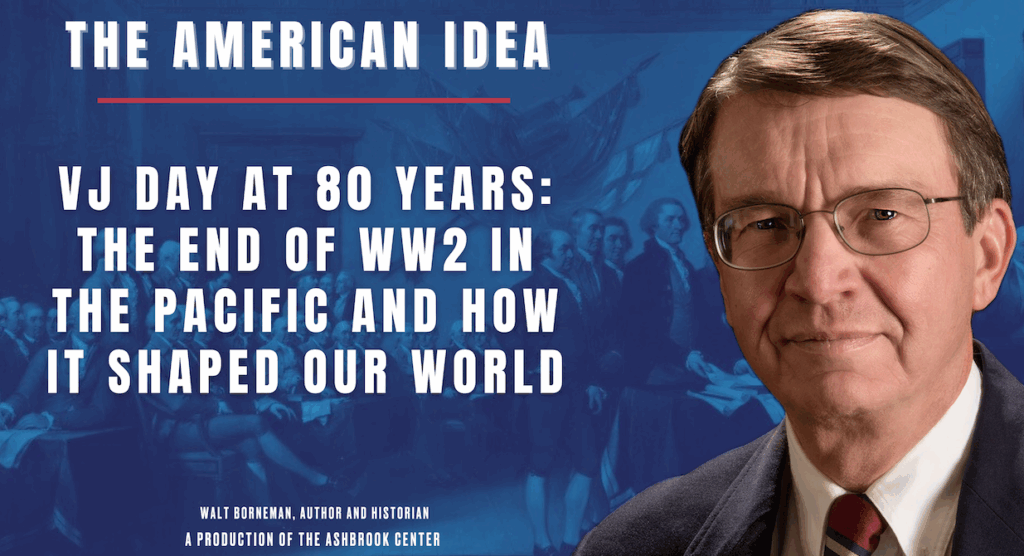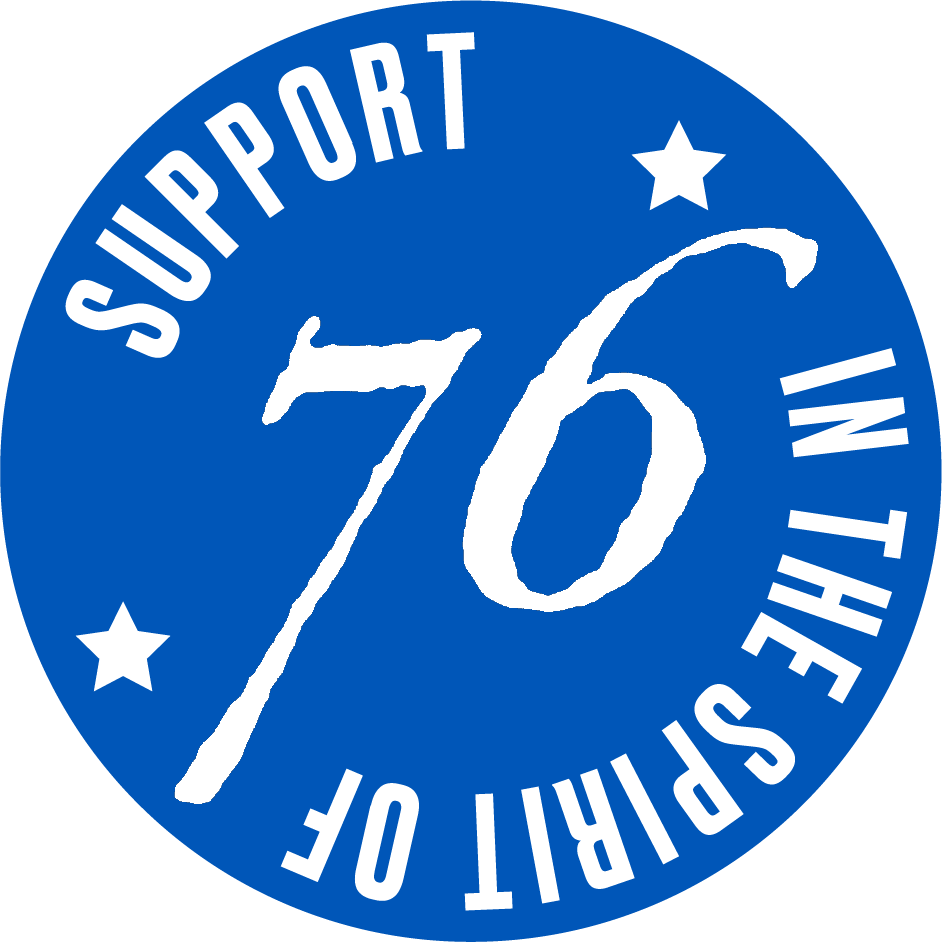How did WW2 Really End? VJ Day at 80 Years
August 13, 2025

Listen and subscribe to the podcast
Join The American Idea’s Listener Email list – get news about upcoming episodes and a chance to offer questions for them, too!
When Americans recall the heroes of World War II, certain names roll off the tongue with practiced ease: MacArthur, Patton, Eisenhower. These generals have claimed their rightful place in our collective memory, their exploits immortalized in countless books and films. Yet lurking in the shadows of this well-trodden narrative are four naval admirals whose strategic brilliance and political acumen proved just as decisive in bringing the Pacific War to its conclusion. Chester Nimitz, Ernest King, William “Bull” Halsey, and William Leahy orchestrated a complex endgame that would reshape not only the conclusion of World War II but the very foundations of the emerging Cold War.
The oversight of these naval commanders reflects a broader historical blind spot. While the European theater commands our attention with its clear geographical progression and dramatic set pieces, the Pacific War unfolds as a more diffuse, maritime affair—one where admirals, not generals, called the shots. Ernest King, serving as both Chief of Naval Operations and Commander-in-Chief of the U.S. Fleet, advocated early for a global strategy that would prevent the Pacific from becoming merely a sideshow to the European campaign. His vision of simultaneous pressure on multiple fronts would prove prescient, even as it violated fundamental military doctrine.
The Gamble of Divided Forces
By early 1945, American forces were executing what military theorists would normally consider strategic heresy: dividing their strength in the face of a determined enemy. Two massive drives swept across the Pacific simultaneously—Nimitz commanding the Central Pacific thrust through the Marianas toward Okinawa, while MacArthur spearheaded the Southwest Pacific campaign through New Guinea back to the Philippines. This dual approach flew in the face of conventional wisdom, yet it stemmed from a combination of MacArthur’s oversized personality and sound strategic reasoning.
MacArthur’s insistence on returning to the Philippines wasn’t merely ego-driven theatrics, though his famous “I shall return” proclamation certainly carried personal weight. The Philippines sat astride Japan’s crucial supply lines from the resource-rich Dutch East Indies, making their capture strategically vital. Moreover, MacArthur harbored genuine concern for the Filipino people who had suffered under Japanese occupation. The Joint Chiefs found themselves managing not just military logistics but also MacArthur’s considerable political capital and media savvy—a delicate balance that somehow produced results despite defying textbook strategy.
As Germany’s surrender in May 1945 shifted full attention to the Pacific, American planners faced an agonizing choice among four potential paths to victory. A direct invasion of the Japanese home islands promised horrific casualties, particularly given the ferocious kamikaze resistance that had intensified as American forces drew closer to Japan. Continued conventional bombing offered a slower but less costly approach, systematically reducing Japanese cities to rubble. A naval blockade might starve Japan into submission over time, though the timeline remained uncertain. Then there was the fourth option—one known only to a select few—that would render all other calculations moot.
The Secret Within the Secret
The atomic bomb project represented perhaps the war’s most closely guarded secret, yet even within that circle of secrecy, information flowed unevenly among America’s military leadership. William Leahy, serving simultaneously as Roosevelt’s Chief of Staff, Chairman of the Joint Chiefs, and National Security Adviser, knew everything from the project’s inception. Admiral King learned of the weapon’s development in 1943, while Nimitz wasn’t briefed until February 1945. Most remarkably, MacArthur—despite his prominent role in Pacific operations—remained completely in the dark until just ten days before Hiroshima, a testament to his colleagues’ distrust of his discretion with the press.
The admirals’ reactions to this revolutionary weapon revealed the profound psychological shift it represented. These were men who had cut their teeth in the battleship era, witnesses to the evolution from big guns to carrier aviation, now confronting warfare’s quantum leap into the atomic age. Leahy expressed skepticism about both the weapon’s functionality and its moral implications, proving remarkably prescient in his warnings about nuclear proliferation. Nimitz’s melancholy observation that he had been “born too late” captured the existential displacement felt by career naval officers suddenly confronting obsolescence.
When Harry Truman inherited both the presidency and the atomic decision, he did so as perhaps the least prepared commander-in-chief in American history regarding this particular choice. Having learned of the Manhattan Project only after Roosevelt’s death, Truman relied heavily on Leahy’s counsel in navigating both the technical possibilities and strategic implications. The decision to deploy the weapon reflected not some grand geopolitical chess game against the Soviet Union, but rather the judgment of an overwhelmed leader seeking the swiftest possible end to a war that had already consumed too many lives.
Endings and Beginnings
The Japanese surrender ceremony aboard the USS Missouri on September 2, 1945, marked both an ending and a beginning. MacArthur’s dignified performance as Supreme Allied Commander, alongside Nimitz’s signature representing the United States, symbolized American power at its absolute zenith. Yet even as they accepted Japan’s capitulation, the seeds of future conflict were already germinating in misunderstandings about wartime agreements and postwar arrangements.
The tragic irony of Yalta had already begun to unfold. Roosevelt’s pragmatic acceptance of Soviet influence in Poland—captured in his frank admission to Leahy that the agreement’s language could “stretch all the way to Washington” without technically breaking—contrasted sharply with Secretary of State James Byrnes’s more optimistic interpretation. When promised “free and fair elections” predictably failed to materialize under Soviet oversight, Truman felt betrayed by agreements he had never made, setting the stage for decades of superpower confrontation.
The Pacific War’s conclusion thus reveals the complex interplay between personality, strategy, and circumstance that shapes historical outcomes. While the atomic bomb provided the dramatic punctuation mark, the war’s end resulted from countless strategic decisions made by naval leaders whose names rarely appear in popular histories. Their story reminds us that even in an age of revolutionary weapons, human judgment remains the decisive factor in determining not just how wars end, but what kind of peace follows.
Order Walt’s book, The Admirals, here.

